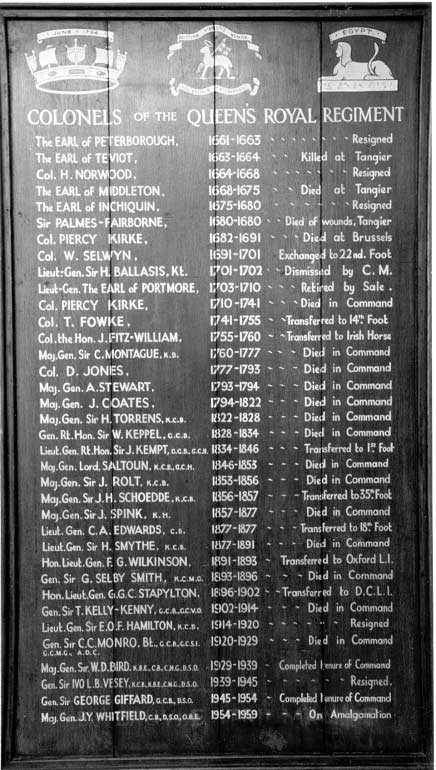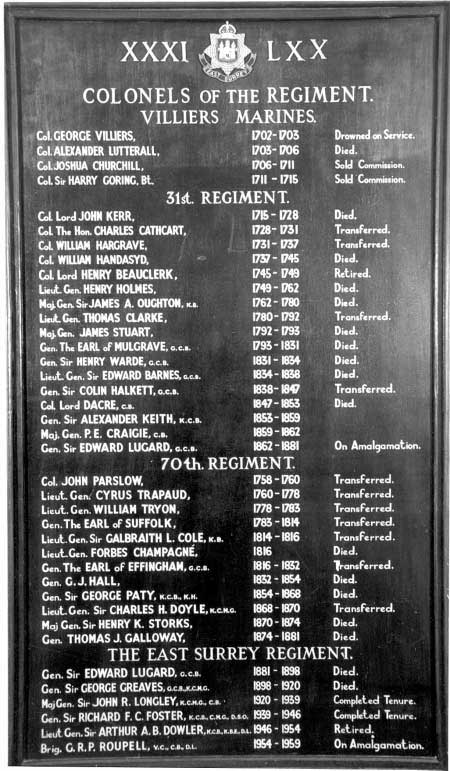The Colonels of the Regiments
See full list for The Queen's Royal Regiment here »
 |
|
| Colonels of The Queen's Regiment . (Click to enlarge) |
|
Visitors to the Regimental Museum will see, in the corridor, two wooden panels hand-painted with details of fifty-one officers who, in the past, were honoured with the appointment of Colonel of the Regiment. Completed in 1962 and known as the Regimental Boards, they name all (or nearly all) of the Colonels of The Queen’s Royal Surrey Regiment’s forebears from 1661 onwards. Those ancestors comprised the 2nd or Queen’s Royal Regiment, the 31st (Huntingdonshire) Regiment and the 70th (Surrey) Regiment. Under the Cardwell Reforms in 1881, the 31st and 70th amalgamated to form The East Surrey Regiment.
The Queen’s Royal Regiment and The East Surrey Regiment amalgamated in 1959 to form The Queen’s Royal Surrey Regiment. That new title was to last only seven years, for in 1966 a further amalgamation took place and The Queen’s Royal Surrey Regiment merged with The Queen’s Own Buffs (The Royal Kent Regiment), The Royal Sussex Regiment and The Middlesex Regiment (The Duke of Cambridge’s Own), to become The Queen’s Regiment, A further merger in 1992 saw The Queen’s Regiment link with The Royal Hampshire Regiment to form The Princess of Wales’s Royal Regiment (Queen’s and Royal Hampshires).
 |
|
| Colonels of The Regiment 3lst & 70th (Click to enlarge) |
|
Like many other Regiments the evolution of The Queen’s Royal Surrey Regiment reflects the much greater changes, over three centuries, of the structure of the British Army in general and the meaning of the title “Colonel” in particular. In modern times, it has become an appointment rather than a rank. It is an honour conferred upon a senior officer (active or retired) who has usually but not necessarily served with the regiment in the past, and it requires the approval of the Sovereign and, if the Regiment has one, its Colonel-in-Chief (who is always a person of royalty, usually British but sometimes foreign).
The Colonel is kept informed of all happenings within the regiment to which he has been appointed and, if so requested by one or more of the battalion commanders, will give advice on matters concerning the overall welfare of the regiment and its institutions. He accompanies the Colonel-in-Chief on every visit which he or she may make to the regiment. He also makes regular visits of his own, not only to the Regular battalions but also to their affiliated volunteer units.
The appointment ensures a continuing strand in the regiment’s esprit de corps, and it provides a channel of communication (formal and informal) with other elements of the army and with higher command. The term is usually for five years, but this can be extended and, as will be seen from these pages, some of our own former Colonels held the post for very many years. Those who instead resigned after only a brief period usually did so for financial reasons or because the regiment had been despatched to a distant garrison and they could therefore no longer maintain the required close contact.
The Regimental Boards at Clandon Park cover three hundred years of colonelcies by men who, in their day, were admired and respected for their military experience and social status. The exploits of the most distinguished are today easy to trace because they were well recorded by their contemporaries. Others, however, have receded into history as obscure figures of whom little is now known. The name of at least three of them are missing from the Boards, and the details given for two or three others are either inaccurate or cannot be substantiated. Even so, these panels provide an excellent point of departure for anyone wishing to study the colonelcies in greater detail, and to build upon the following individual entries.
Readers are reminded that the dates shown are for the period the Officer held the appointment of Colonel.
